How to Most Effectively Tenderize Steak
Salts, and enzymes, and aging (and pounding and bacteria and heat), oh my.
The idea of earning your keep is nothing new. Paul the Apostle said as much in his letter to the Thessalonians: If anyone is not willing to work, neither should he eat. But it's one thing to work for our food, and another for our food to make us work, which is to say—no one wants to gnaw on a hunk of un-chewable meat.
There are many cuts of steak and other meats that are prized for their inherent tenderness, the aptly named tenderloin chief among them. But even tougher cuts can produce high-quality results, if you know how to transform them. And here's the shocker of shockers: There are many ways to do that. We're going to look at the major methods of meat tenderization so you can choose the technique that best fits your needs.
Why Is Some Meat Tough?
To understand why meat needs to be tenderized, let’s first take a closer look at what makes meat, well, meat. There are many definitions for meat and what it could include, but for this article, meat will refer to the skeletal muscle tissue of warm-blooded animals that contains little to no fat attached to it (a definition like this is what you get when you come to a science-focused food site!).
Skeletal muscle is a type of animal tissue that specifically describes muscles that attach to bone and allow them to move (as opposed to the smooth muscles found in the digestive system and arteries and the cardiac muscle of the heart). Skeletal muscle is composed of thousands of muscle fibers held together as bundles, which are wrapped together by sheaths made up of connective tissue.
That connective tissue, meanwhile, is rich in proteins like collagen, which plays an important role in meat tenderness. During cooking, the collagen in that connective tissue loses water, causing it to shrink; this in turn squeezes the muscle fibers within like a hand squeezing a sponge, causing the meat to lose even more water. This can lead to a drier and tougher texture. As we'll see, though, the collagen in some cuts of meat can be broken down or transformed, leading to more tender results.
Even within the same animal, tenderness varies by cut. That's why the same cow or pig can offer an incredibly soft cut like the tenderloin alongside a famously chewy one like the shank. Much of the difference in tenderness between cuts comes down to how the muscle is used by the animal during its life. Muscles that are hard-working, especially ones that are used to support the animal or propel it, need to be stronger, and thus are loaded with more toughness-causing collagen. Weaker muscles that aren't used nearly as much, on the other hand, tend to remain lower in collagen, and are thus more tender.
Other factors that can influence meat tenderness include the age of an animal, the specific breed, individual genetics, and sex.
How Meat Tenderness Is Evaluated
Meat tenderness can be evaluated and reported as a sensory measure—how tender it feels, and how easy it is to chew. However, if you want to be more specific, you can determine the tenderness of meat using scientific methods like the Warner-Bratzler shear test. The premise is simple, though a little tricky to execute on a practical level (you need several samples, and the shearing blade dulls quickly with repeated use). First, a steak or a piece of meat is cooked and cooled. The cooled meat is then placed in a device called the Warner-Bratzler Meat Shear Fixture, and the amount of force needed to cut the meat is measured. The greater the force, the tougher the cut of meat.
Since most of us don't have Warner-Bratzler Meat Shear Fixtures sitting next to our food processors, it's easier to list some of the most common cuts that we often want to tenderize.
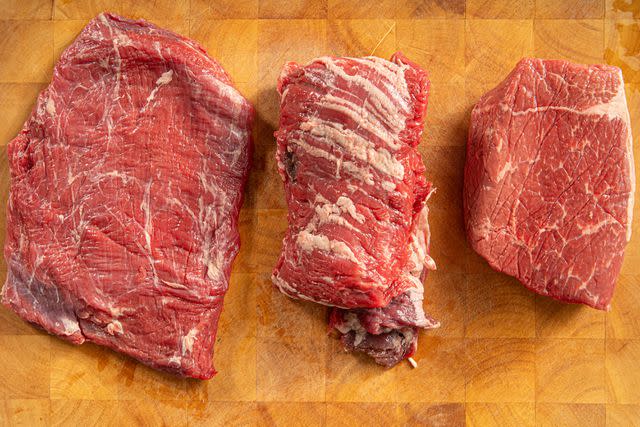
Serious Eats / Amanda Suarez
Tough Cuts of Beef and Other Meats
While not an exhaustive list, the following are some of the cuts that are frequently thought to be tough. The reason for toughness can include any combination of the following: Some of these cuts are very hard-working, like the shanks, so they're loaded with strong but chewy collagen; others are very lean, making them prone to toughness and dryness, especially if overcooked; and some, like the flank steak and brisket, have thick and ropey muscle fibers.
Shanks
Brisket
Short ribs
Shoulder/chuck
Flank steak
Top Round Roast
Bottom Round Roast/Rump Roast
Top Sirloin
Bottom Sirloin
Oxtail
Cheeks
Ways to Tenderize Meat
In general, all methods of meat tenderization manipulate the meat’s texture to improve its palatability. Even if the goal of tenderness is the same, the methods span a wide range of tactics from physical to chemical and biological.
Physical Methods of Meat Tenderization
Force: Pounding, Massaging, Cutting, and More
The simplest and perhaps easiest method to tenderize meat is to manipulate it physically by altering its structure with force—think of it something like pre-chewing, but…way less gross.
Force can be applied by massaging, pounding, puncturing, scoring, slicing, and agitating the meat. Mallets and meat pounders, for example, can be used to hammer steaks and thin slices of meat; the heavy force from banging the meat breaks up the connective tissue and collagen around the muscle fibers, causing the muscle fibers to separate and the meat to be more tender.
In addition to a meat pounder, another popular meat-tenderizing tool is the Jaccard, a device that contains several blades that, when pressed against the surface of the meat, cut through the muscle fibers. In commercial settings, meat is also sometimes "tumbled" (this is also called "massage" or "vacuum" tumbling). In this method, meat is agitated by tossing it around in an enclosed tumbler with a seasoning or marinade. While commercial applications involve applying a vacuum, you can do this at home in an enclosed jar or container using a food vacuum storage device or special tumbler just for meat.
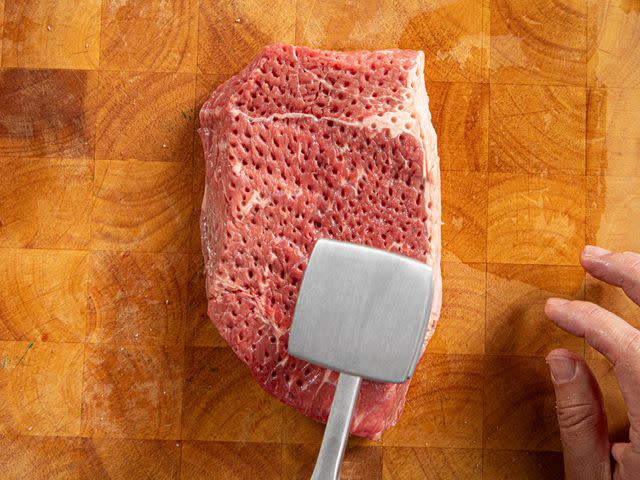
Serious Eats / Amanda Suarez
In truth, you don't even always need a device for physical tenderization to work. In Kenji's recipe for dim sum pork ribs, he takes a page from Chinese chefs by very vigorously massaging the ribs with his hands to break up and soften the flesh, so that the ribs come out tender after just a short steaming period.
Shockwave technology is yet another tenderization method you're unlikely to encounter at home, but it is of interest to the food industry. It generates shockwaves via controlled explosions or electrical discharges that exceed the speed of sound in water; as they pass through the meat, they rupture its structure.
Returning to more practical methods, one of the most useful tenderizing tools is a good old knife. By cutting meat across the grain either before or after cooking, long and tough muscle fibers are shortened to much more manageable bits that are far easier to chew. This is one reason roast beef, which is often made from a lean, toughness-prone cut, is sliced so thinly on a deli slicer.
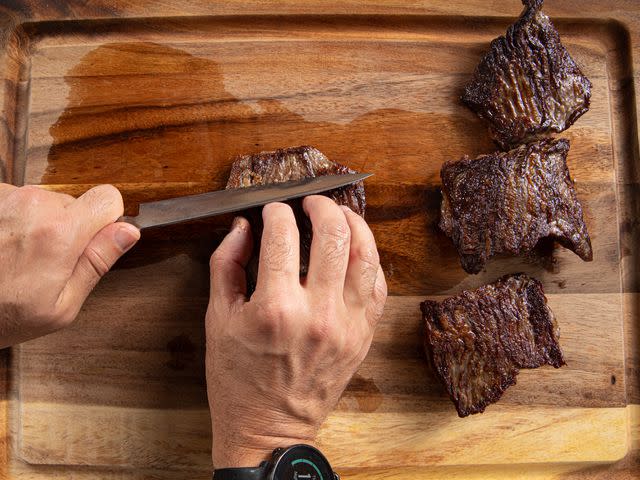
Serious Eats / Amanda Suarez
In South Asian cooking, deep gashes are often made across large cuts of meat. These gashes nip the long muscle fibers, allowing meat marinades to penetrate deeper and making the meat tender and less chewy to eat. You might have come across a simpler version of this technique in recipes in which you're instructed to prick the surface of the meat with a fork or knife before cooking. For that matter, grinding meat can also be thought of as a method for making a tough cut of meat more tender—some of the most flavorful burger blends use tough cuts like brisket, short rib, and more for maximum flavor without any risk of toughness thanks to the grind of the meat. The aggressive physical destruction of the meat via grinding produces a juicy and tender texture that wouldn’t otherwise be possible with the whole pieces before they went through a grinder.
As you can imagine, most of these physical tenderizing methods are harsh and can affect the appearance of the meat, which may or may not be desirable in the final product—no one will complain about the ground meat in a burger patty, but they may not be thrilled with a steak that got hammered to mush with a meat pounder (unless, of course, the recipe was meant to produce a pancake-thin cutlet, in which case, yay!).
Heat: Low-and-Slow or Sped Up With Pressure
Another physical manipulation of meat is with heat itself, which can be enhanced and sped up with the help of a pressure cooker. Given a long enough cooking time, such as in a low-and-slow braise or barbecue, tough collagen melts into tender gelatin, transforming previously difficult-to-chew cuts into a miracle of silkiness and succulence. In the high-pressure environment of a pressure cooker, this conversion of collagen to gelatin happens even faster, reducing something like a three-hour braise to something that cooks in under an hour.
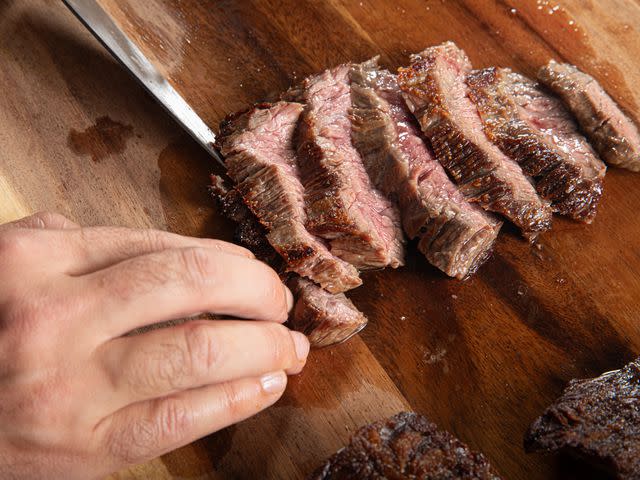
Serious Eats / Amanda Suarez
Chemical Methods of Meat Tenderization: Salts
Salt, both sodium chloride—the salt most of us are talking about when we say "salt" in the kitchen—plus many other salts in the scientific sense of the word, can act as powerful meat tenderizers. When dissolved in water, sodium chloride can dissolve some muscle proteins like actin and myosin; this is true whether the salt is dissolved in a wet brine or in the meat's own juices after the salt has been applied in a dry brine. This not only tenderizes the meat by breaking apart some of the muscle's structure, but it also lessens the degree to which a piece of meat contracts during cooking. Less contraction means less juices being squeezed out, leading to an overall more plump and tender piece of meat.
It's safe to say that of all the tenderization methods out there, applying salt in one form or another is almost always a good choice: It seasons the meat (almost never a bad thing) and improves both texture and juiciness. It's almost entirely pro with very little con.

Other salts that can be used as tenderizers include baking soda and salts of phosphoric acid or phosphates that can also dissolve muscle proteins and improve the tenderness and juiciness of the meat. As we found in a series of marinade tests, while baking soda is a tenderizer, it can also produce some unfortunate effects on a piece of meat and should be used with caution. Salts of phosphates are commonly used to tenderize meats like pork, for example—check the ingredient list on the label of pre-brined pork loin from a grocery store, and you’ll notice phosphates included.
At home, you can take advantage of the tenderizing effects of phosphates by using dairy. Dairy in the form of milk or fermented milk products like yogurt, buttermilk, or kefir contains a large number of phosphates that will improve the texture of meat. In addition to the salt and phosphates, fermented dairy contains lactic acid, a wonderful meat tenderizer that my own tests showed is not as prone as other common kitchen acids to turning the meat mushy.
Another common pantry staple that can help tenderize meat is mayonnaise, an emulsification traditionally made from egg yolks, vinegar or lemon juice, and oil. Egg yolks are rich in phospholipids, phosphates, and proteins, all of which help solubilize proteins in meat while amping up and stabilizing the emulsification of protein, fat, and water that forms on the surface of the meat. The meat locks in more water, resulting in a juicier, tender cut.
Biological Methods of Meat Tenderization: Aging, Enzymes, and Bacteria
Enzymes and Aging
One could correctly argue that enzymes are technically chemicals, and therefore belong in the section above on chemical methods of meat tenderization. But I prefer to include them under the biological tenderization umbrella, since they derive from biological sources and processes.
Humans have tenderized meat with enzymes, even if they didn't know they existed, since ancient times. In Korea, pear juice was applied to meat before cooking and in tropical and subtropical countries, papaya leaves and fruit were added to meat to make it more tender. These fruits contain enzymes called proteases that can recognize proteins and snip them up like scissors.
Besides pears and papayas (the enzyme is called papain), other plant sources of proteases include pineapples (bromelain, the key active ingredient in Adolph’s brand tenderizer), figs (ficin), kiwis (actinidain), melons, ginger (zingibain), and mangoes. These enzymes only work on the surface of the meat they come into contact with, since proteases are large protein molecules and cannot penetrate deeply into the meat.
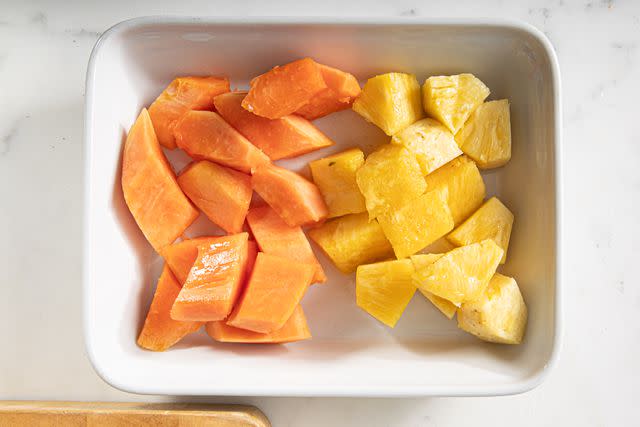
Serious Eats / Amanda Suarez
In addition, the enzymes from these fruits will only work if raw, and some fruits, like papayas, must come from unripe fruits. Canned and cooked fruit won’t work as meat tenderizers because the protease enzymes get inactivated and denatured during heating. Protease enzymes can also be obtained from animal sources, and some of these, like trypsin, pancreatin, and pepsin, are used to tenderize meat.
Keep in mind, though, that enzymes require optimum conditions (temperature, pH, and time) to work efficiently.
When an animal dies, the tissue cells send signals that activate a cascade of biochemical signals to induce destruction. This process is known as apoptosis or "cell death." Enzymes within the muscle cells and the extracellular matrix kick into full gear and start degrading muscle proteins, making the meat more tender.
Under optimal storage conditions, meat can be aged such that we can take advantage of the benefits of cell death without the meat actually going bad. Beef can be aged by dry or wet methods. In dry aging, the beef is stored in a cold refrigerator unwrapped while in wet aging, the meat is vacuum packed before storage.
When meat is aged properly (some like to say it's being "ripened" or "conditioned"), its texture, and sometimes flavor, are noticeably improved. During this period, the muscles undergo various biochemical reactions like proteolysis, lipolysis, and oxidation that produce changes in the muscle's protein and fat content, improving the meat’s flavor, color, and texture.
Bacteria
Bacteria can also be used to “live tenderize” meat. Lactic acid bacteria in fermented dairy like yogurt produce proteases that not only cut the proteins in milk but also in meat, producing new flavors and textures as a result. In some countries, meat is fermented to increase its longevity and change flavor and texture. For example, hákarl is prepared in Iceland by fermenting shark for several months. Sausages like Iberian chorizo and nem chua from Vietnamese cuisine are also examples of spiced fermented meats.
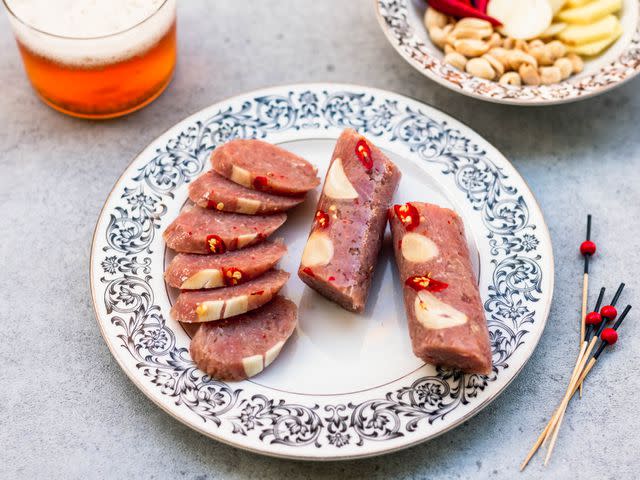
Using biotechnology, protein enzymes can be produced on an industrial scale from bacteria like Bacillus subtilis and fungi like Aspergillus niger. It’s been reported that these commercially produced bacterial and fungal enzymes work on the proteins of the muscle fiber. In contrast, plant, microbial, and animal enzymes work more broadly by cutting both muscle and connective tissue proteins. The latter enzymes produce more tender meat by comparison.
It's worth noting, though, that both chemical and biological methods of meat tenderizing primarily act on the surface of the meat and don’t always penetrate all the way through to the interior. This can be alleviated by using a combination of physical, chemical, and biological methods to help increase the surface area of the meat, increasing the sites where chemicals and enzymes can come into unimpeded contact with the meat. Tools like meat injectors can also help deliver tenderizers deeper into the muscle for a more even tenderizing effect.
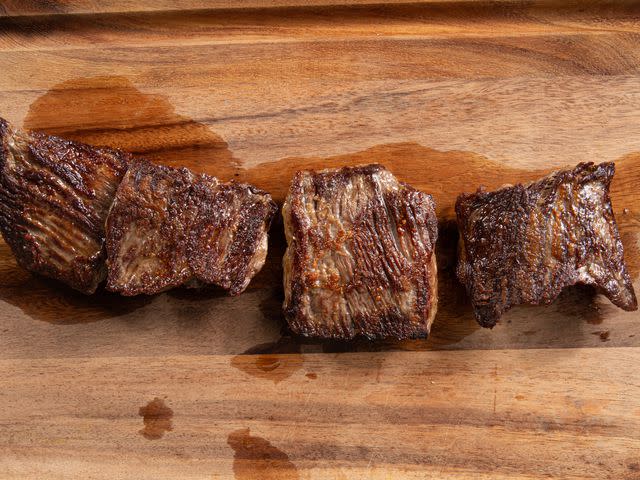
Serious Eats / Amanda Suarez
Conclusions
As you can see, there are many ways to turn a tough piece of meat into a tender one. Among the most practical for home cooks are salt, thoughtful knife cuts to shorten muscle fibers and increase surface area, pounding and massaging to break up tough muscle tissue, and the correct application of heat. Additional tenderization methods like enzymes in marinades, other salts like baking soda, and bacteria (via fermentation) have their place, but can also have more drastic effects on the meat that may not always, or even often, be desirable.

